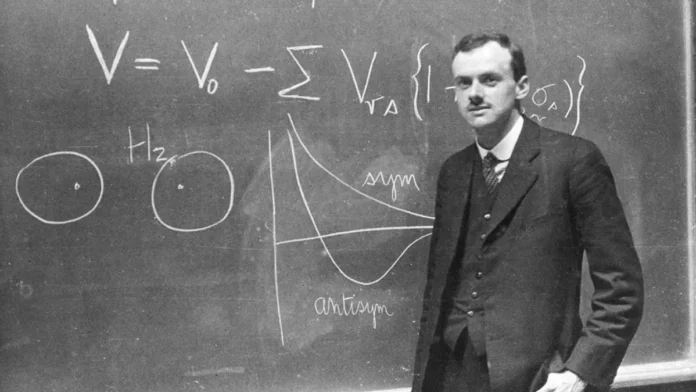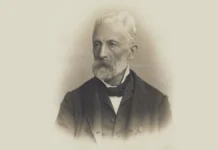Paul Dirac was an Engineer who turned Physicist. His work not only revolutionized our understanding of the fundamental forces governing the universe but also paved the way for the development of modern theoretical physics. In simple means, he changed how we think about the tiny bits at the atomic and quantum levels that make up things and how they work together. Born in 1902, Dirac’s journey from engineering to physics showcases a remarkable transformation who went from being an engineer to being a big shot in physics. In this article learn more about him.
Contents
General Information
- Full name: Paul Adrien Maurice Dirac
- Born: August 8, 1902, in Bristol, England
- Married: Margit “Manci” Wigner, 1937
- Children: Judith & Gabriel (Margit’s children whom Paul adopted) followed by Mary Elizabeth and Florence Monica.
- Died: October 20, 1984, in Tallahassee, Florida
Early Life and Education
Charles and Florence Holten Dirac welcomed Paul Adrien Maurice Dirac in Bristol, England on August 8, 1902. His mother was a native of Cornwall, while his father was an immigrant from Switzerland who taught French. Dirac exhibited exceptional aptitude in science and mathematics at a young age, displaying an intuitive brilliance that would ultimately lead him to become one of the greatest physicists of the 20th century.
Paul Adrien Maurice Dirac was recognized for his aptitude for academics at Primary School. Later, he pursued engineering at Merchant Venturers’ Technical College, now known as the University of Bristol. Despite his initial interest in engineering, Dirac’s passion for theoretical physics continued to grow and eventually led him to switch disciplines. Charles and Florence Holten Dirac were his parents who welcomed him into the world.
His Transition to Physics
Dirac’s transition from engineering to physics was driven by his fascination with the profound theories of relativity and quantum mechanics. This exposure ignited a strong desire within him to explore the mysteries of the universe further. After completing his degree in electrical engineering from the University of Bristol in 1921, Dirac set out on a transformative journey that would reshape the field of modern physics.
Quantum Mechanics and The Dirac Equation
Dirac’s revolutionary contributions to physics center around the Dirac Equation. This fundamental equation reconciles quantum mechanics with special relativity and establishes the groundwork for the field of quantum field theory. He introduced this equation in 1928, and it describes the behavior of fermions, particles like electrons that have half-integer spin, within the framework of relativistic quantum mechanics. The Dirac Equation was pivotal in advancing our understanding of the behavior of subatomic particles and remains a cornerstone of modern physics.
The Dirac Equation is a significant contribution to the field of physics, as it not only predicted the existence of antimatter but also provided profound insights into the nature of particle interactions and the underlying symmetries of the universe. Dirac’s formulation of the equation represented a pivotal milestone in the quest to unravel the mysteries of the subatomic realm, serving as a cornerstone of modern theoretical physics.
Antimatter and the Positron
One of the most remarkable predictions arising from Dirac’s equation was the existence of antimatter, a concept that defied conventional wisdom and sparked intense speculation within the scientific community. In 1932, the experimental discovery of the positron, the antiparticle counterpart to the electron, provided empirical validation for Dirac’s theoretical framework, cementing his status as a visionary physicist.
Dirac’s deep understanding of antimatter transformed our comprehension of particle physics and opened up new avenues for innovative discoveries in experimental physics. His work laid the foundation for developing particle accelerators and studying high-energy particle collisions, enabling us to explore the universe’s fundamental building blocks in once unimaginable ways.
Quantum Electrodynamics and The Dirac Sea
Dirac’s contributions to quantum mechanics were seminal, but he also played a pivotal role in the development of quantum electrodynamics (QED). QED is the theory that describes the interactions between charged particles and electromagnetic fields. Central to Dirac’s formulation of QED is the concept of the Dirac Sea, which hypothesizes that an infinite sea of negative-energy electrons fills the vacuum. This theoretical framework has been instrumental in advancing our understanding of the universe and its underlying principles.
Despite the initial controversy, the Dirac Sea hypothesis was a significant conceptual framework that helped understand the behavior of charged particles and the complex dynamics of quantum fields. Although later advancements in quantum field theory, such as Feynman diagrams and renormalization techniques, refined our understanding of QED, Dirac’s foundational contributions were critical in establishing the modern formulation of the theory.
Legacy and Impact
Paul Dirac’s impact on the scientific community is not limited to theoretical physics. His legacy is far-reaching and continues to influence the scientific community today. His pioneering work revolutionized our understanding of the fundamental forces that govern the universe and inspired generations of physicists to explore uncharted frontiers of theoretical inquiry. Dirac’s contribution to theoretical physics has been invaluable and his influence on the scientific community is a testament to his enduring legacy.
Dirac was a pioneer of theoretical physics who was renowned for his unwavering commitment to mathematical elegance and conceptual clarity. His approach to science serves as a shining example for aspiring scientists who seek to understand the mysteries of the universe. Dirac’s impact on modern physics is profound and continues to inspire scientists around the world. His legacy is a testament to the limitless potential of human intellect and the power of scientific inquiry to unlock the secrets of the cosmos.
Paul Dirac’s impact on the scientific community goes beyond just theoretical physics. His legacy is profound and continues to resonate within the scientific community to this day. He is remembered for his pioneering work that revolutionized our understanding of the fundamental forces that govern the universe. Furthermore, his work has inspired generations of physicists to explore new uncharted frontiers of theoretical inquiry.
Dirac was a renowned physicist who had many famous students including Homi J. Bhabha, Fred Hoyle, John Polkinghorne, and Freeman Dyson. According to Polkinghorne, Dirac believed that the fundamental laws of nature should be expressed in beautiful equations. When asked about his fundamental belief, Dirac walked up to a blackboard and wrote this statement.
Also Read:
Dirac’s unwavering pursuit of mathematical elegance and conceptual clarity serves as a beacon of inspiration for theoretical physicists seeking to unravel the mysteries of the universe. His profound influence on modern physics stands as a testament to the limitless potential of scientific inquiry and the power of human intellect.
Awards and Recognition
- 1930 – elected a Fellow of the Royal Society
- 1933 – Nobel Prize in Physics
- 1939 – Royal Medal (also known as the Queen’s Medal) from the Royal Society
- 1948 – Honorary Fellow of the American Physical Society
- 1952 – Copley Medal
- 1952 – Max Planck Medal
- 1969 – J. Robert Oppenheimer Memorial Prize (inaugural)
- 1971 – Honorary Fellow of the Institute of Physics, London
- 1973 – Member of the Order of Merit
Conclusion
Paul Dirac’s transition from engineering to physics is a true testament to the power of intellectual curiosity and imagination. His groundbreaking work in quantum mechanics and quantum electrodynamics has completely transformed our understanding of the universe, providing insights into the complex fabric of nature’s underlying symmetries and principles. In summary, Dirac’s journey serves as an inspiration to the scientific community and highlights the importance of pursuing a theoretical inquiry into the unknown frontiers of our universe.
As we reflect on Dirac’s monumental legacy, we are reminded of the enduring spirit of scientific inquiry that transcends the boundaries of time and space. His profound insights into the nature of reality continue to inspire and challenge us, beckoning humanity to venture forth into the unknown realms of knowledge and discovery. Paul Dirac’s name shall forever be etched as a beacon of enlightenment, guiding humanity toward a deeper understanding of the cosmos and our place within it. His contributions to the field of science serve as a reminder of the power of human curiosity and the unending quest for knowledge that drives us forward.
Sources
- Bhabha, Homi Jehangir (1935). On cosmic radiation and the creation and annihilation of positrons and electrons (PhD thesis). University of Cambridge.
- Harish-Chandra, School of Mathematics and Statistics, University of St Andrews.
- Kragh, Helge. Dirac: a scientific biography. Cambridge University Press, 1990.
- Farmelo, Graham. The strangest man: the hidden life of Paul Dirac, quantum genius. Faber & Faber, 2009.
- Pais, Abraham, et al. Paul Dirac: the man and his work. Cambridge University Press, 2005.
- Kragh, Helge. “Paul Dirac and the principles of quantum mechanics.” (2013).
- McCubbin, Norman. “Beauty in physics: the legacy of Paul Dirac.” Contemporary physics 45.4 (2004): 319-333.
FACT CHECK: We strive for accuracy and fairness. But if you see something that doesn’t look right, please Contact us.
DISCLOSURE: This Article may contain affiliate links and Sponsored ads, to know more please read our Privacy Policy.
Stay Updated: Follow our WhatsApp Channel and Telegram Channel.














